#pro design construction
Text



I re-designed/tweaked the football uniforms for the es21 uni teams because what little we see of them in canon is BORING--
#eyeshield 21#es21#i know real pro football uniforms are generally boring#buutttt this is es21 which means they are obligated to be fun#so there#i also designed mascots so i'll post those soon#saikyoudai wizards#enma fires#takekura construction babels#my art#fan art
242 notes
·
View notes
Text
youtube
The Future of Technological Advancements | Shaping Our World
Welcome back, tech enthusiasts! In today's video, we are diving headfirst into the exciting realm of the future, exploring the incredible technological advancements that are set to revolutionize our world. From mind-boggling innovations to cutting-edge discoveries.
#ev technology#battery technology#sustainable transportation#battery advancements#cutting-edge technology#latest ev battery technology#future of transportation#construction techniques in architecture#advanced technology in construction#virtual design and construction#new construction technology#advanced building construction techniques#hybrid vs electric cars pros and cons#best electric cars#technological advancements#shaping our world#the future of technological#Youtube
0 notes
Text
Feedback Sports Pro Mechanic Stand launches at Sea Otter

View On WordPress
#aluminum#Bag#bicycle#Components#Construction#Corrosion#Design#durable#elite#Equipment#Eurobike#Feedback#Feedback Sports#Feedback Sports Pro Mechanic Workstand#functional#Lightweight#Packaging#power#Pro#Pro Mechanic HD#repair stand#Retail#road#Rubber#Sea Otter#speed#sports#support#Tape#Travel
0 notes
Text


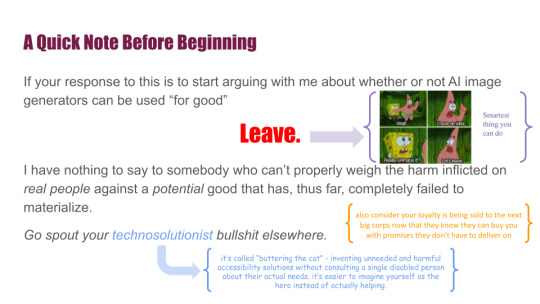
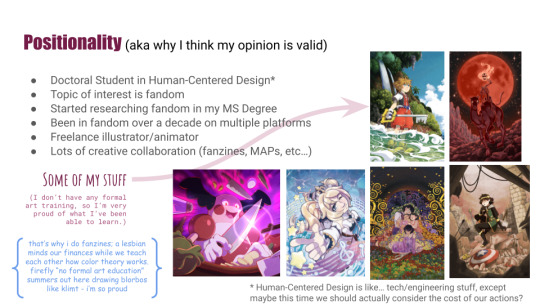
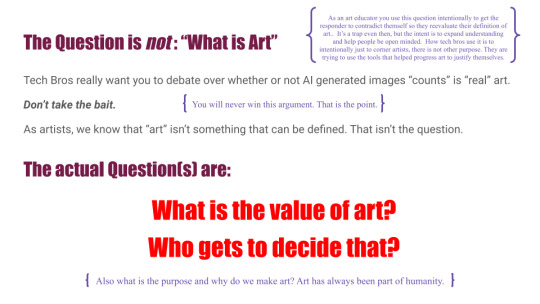
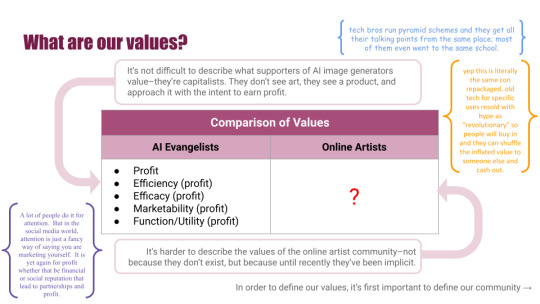
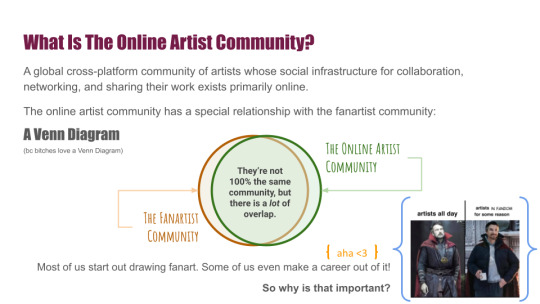
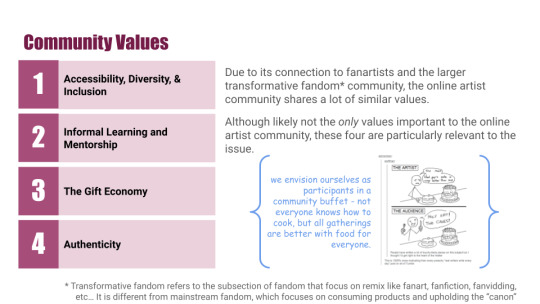

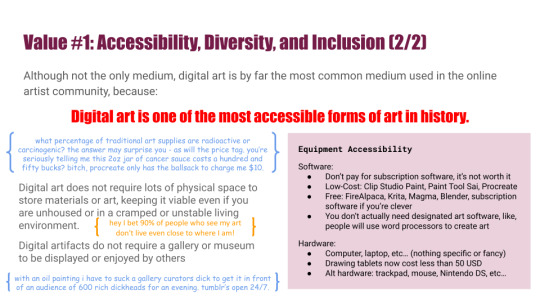

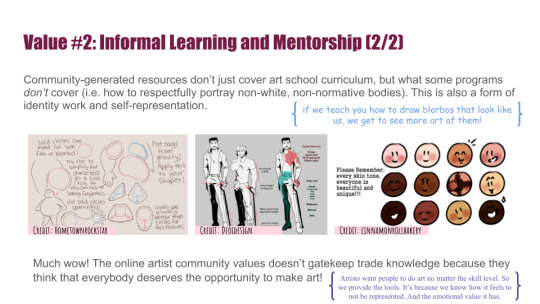
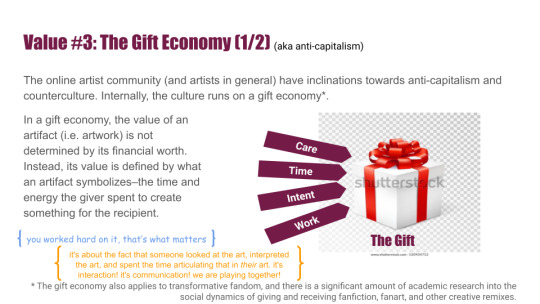

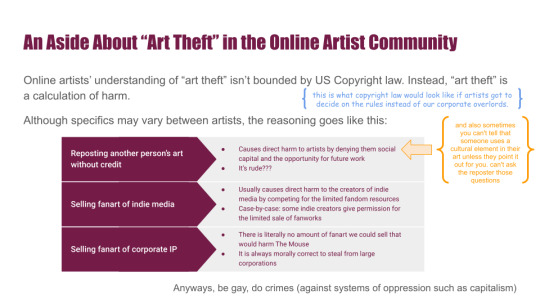

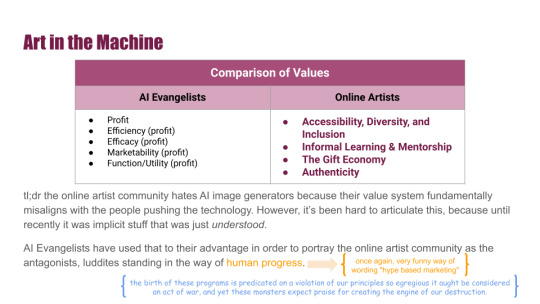
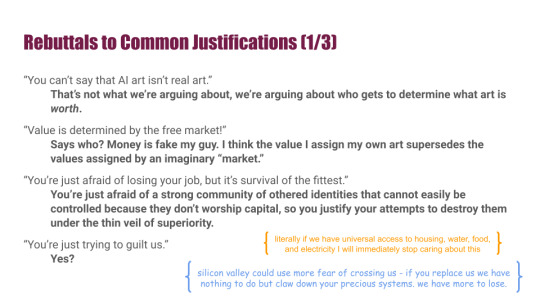
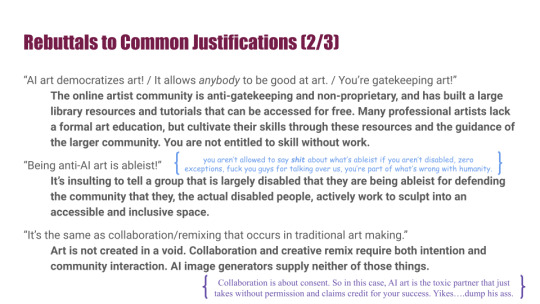

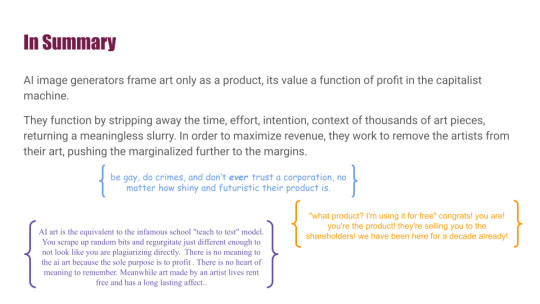
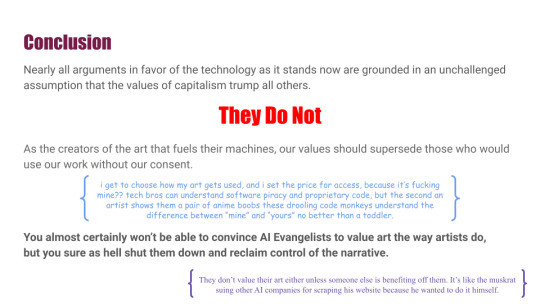

FireflySummers’ Guide to Arguing Against the Use of AI Image Generators
(AKA I hate AI image generators so fucking much that I published a whole ass academic article on it)
Read the Paper: Art in the Machine: Value Misalignment and AI "Art"
Citation: Allred, A.M., Aragon, C. (2023). Art in the Machine: Value Misalignment and AI “Art”. In: Luo, Y. (eds) Cooperative Design, Visualization, and Engineering. CDVE 2023. Lecture Notes in Computer Science, vol 14166. Springer, Cham. https://doi.org/10.1007/978-3-031-43815-8_4
The purpose of the original paper and now this post is the following:
Provide at least one academic article that you can cite. (Full paper + citation available below)
Make explicit community values that have previously been implicit, in order to better examine your own perceptions of the online artist community, and where you sit within it.
Provide rebuttals to common pro-AI talking points, with the intention of shutting down the conversation and reclaiming the narrative.
What this paper and post cannot do:
Act as a sole authority about the online artist community and its values. We are not a monolith, and it is up to you to think critically about what, exactly, you want to take away from this discussion.
Provide a way to convince AI Evangelists that what they’re doing is wrong and bad and needs to stop. You will never convince them. Again, focus on shutting them down and reclaiming the narrative.
Final Disclaimer: I'm a very fallible researcher who is still very much learning how to do academia. I cannot speak for the entirety of the online artist community or fanartist community. We all have different lived experiences. I have done my best to include diverse voices; however if you have concerns or critiques, I am open to hearing them.
If you show up to debate in favor of AI image generators, you will be automatically blocked.
Credits:
Editors, Meme Experts, and Annotators: @starbeans-bags, @b4kuch1n, @cecilioque.
Tutorial Examples: @sabertoothwalrus, @ash-and-starlight, @miyuliart, @hometownrockstar, @deoidesign, @cinnamonrollbakery
If you have read this far, thank you very much. I hope that you have found a constructive lens for approaching the war with AI image generators, as well as a new tool for shutting down debate and reclaiming the narrative.
#anti ai#fuck ai#fuck ai everything#fuck ai bros#anti ai art#ai is theft#ai is a plague#fandom#fandom research#fanart#my academics#that's a new tag for me#long post
3K notes
·
View notes
Text

Back at it again at Krispy Kreme…. Aka the locked tomb.
Cytherea-as-Dulcinea sketch! Eventually I want to design a couple looks for everyone from the first book to match the busts I drew, so this is a start.
I headcannon Dulcie as an ambulatory wheelchair user, but sometimes uses a walker— she likes wheels, and after years of similar cancers her home is extremely accessible.
I also HC that the mythraeum isn’t accessible at all (like Canaan house) so Cyth uses forearm crutches, a cane, or bone constructs/beguiling corpses like Pro in trickier areas when she needs to move more quietly.
#cytherea the first#cytherea loveday#dulcinea septimus#dulcie septimus#gideon the ninth#gideon the ninth spoilers#gtn fanart#gtn spoilers#gtn
2K notes
·
View notes
Text

#Ideal AP40 Pro with WiFi $699.00#Contact: [email protected]#Ideal for room sizes of 400 square feet.* The AP40 PRO is perfect for bedrooms and small commercial offices. Novel 360° multi-layer filter#The compact AP40 PRO combines straightforward design#quiet operation#and energy efficiency. The construction of the device ensures maximum air throughput and optimized filtration. The 360° multi-layer filter#PM2.5#PM0.3#PM0.1)#pollen#and odors from indoor air. The central Easy-Touch control panel provides function modes such as automatic mode#level 1/2/3#turbo#and night mode at one’s fingertip. Additional features such as a timer function#child lock#filter status#and customization of the automatic mode can be operated via the corresponding IDEAL Air PRO app1. On average#the 360° filter lasts 12 months#depending on the intensity of the usage. UL approved. Meets California ozone emissions limit. CARB certified.
0 notes
Text
#VDC#BIM#AEC#scheduling#planning#4D BIM#Synchro Software#Construction Project Management Software#Virtual Design and Construction#Synchro PRO#Construction Scheduling#4D Construction#Construction Software#Bentley Construction Synchro#Synchro ltd#synchro 4d bim#synchro site#synchro 4d bim video#synchro course#synchro scheduling#synchro master class synchro#synchro software#synchro pro#synchro ltd#synchro 4d bim clinic#sycnhro#drone#science#control#zero float
1 note
·
View note
Text
TORONATA - DEVASA+

Toronata's iPhone 15 cases are designed to be compatible with the iPhone 15 Pro Max, iPhone 15 Pro, iPhone 15 Plus, and iPhone 15 case. This means that you can enjoy the benefits of Toronata's high-quality leather wallet case regardless of which model you own. Whether you're looking for a sleek and stylish case for your iPhone 15 Pro Max or a functional and practical wallet case for you iPhone 15 plus case, Toronata has you covered. One of the standout features of Toronata's iPhone 15 pro max case , iPhone 15 pro case is the high-quality leather material used in their construction. This premium leather not only looks and feels great, but it also provides excellent protection for your phone. The case is reinforced with geometric air pockets and elastomer to provide shock absorption, helping to prevent damage to your device in the event of a fall. Additionally, the wallet case features a unique raised edge around the screen and camera to provide added protection against scratches and other damage. The wallet design of Toronata's iPhone 15 cases is another key selling point. With four card slots and a cash pocket, these cases offer plenty of storage space for your essential items, iPhone 15 pro max leather wallet case also features RFID protection, which helps to prevent unauthorized access to your credit card information. Additionally, the case is MagSafe-compatible, allowing you to easily attach and detach your phone from the case. Finally, the kickstand feature of the case allows you to prop up your phone for hands-free viewing, making it an excellent choice for watching videos or taking video calls.
1K notes
·
View notes
Text
You know that thing about buying pink tools if you don’t want them to disappear at a construction site?
I want you all to know IT WORKS.
I work in manufacturing and all my stuff is labeled NINA DO NOT TAKE or RETURN TO NINA in both English and Spanish. I still have to routinely replace my pens and box cutters and once, even my COMPANY-PROVIDED safety glasses that anyone can get entirely for free.
….but there is one item that’s unlabeled, and that fucker NEVER disappears.
I was placing an order from a kawaii grab bag shop on Etsy and the owner had a place to make special requests, and this was mine:
“For the pens, I’d like [design I actually liked], and also the pinkest, girliest, glitteriest, most no-man-would-be-caught-dead pen you have in your stock. I’m tired of people at work stealing my shit so we’re trying something.”
The seller sent me a Barbie-pink pen covered in strawberries. I’m going to have to replace it soon….BECAUSE IT’S WEARING OUT. It has never disappeared. I’ve even lent it out a few times and it always comes back. Guys who borrow it will see it and rapidly see if they can borrow from someone else. (Women never seem to need to borrow pens, almost like they’re used to having to have supplies with them.)
I WILL NEVER STOP CARRYING A PINK PEN TO WORK. It doesn’t even have my name on it and it always stays where I left it.
Genuine pro tip. It works.
189 notes
·
View notes
Text
Vote TangoTek for MCYTblr Sexyman!
- the personification of a cartoon villain
- evil dungeon master (twice)
- fandom assigned Creature
- team rancher
- so much fanart that makes people go feral
- orange cat energy
- makes so so many Noises
- probably bites
- makes death games for fun
- pro ravager wrangler
- have yall SEEN the fanart
- ice and fire. hes got range.
- is so good for angst and drama in aus but in canon he is just a silly
- ok yeah he definitely bites
- i have seen so much variety in tango designs and the only constant is that none of them are human
- and we love a creatureguy here on tumblr!
- constantly on the verge of a villain arc and would probably do one if he wasnt so busy constructing and maintaining massive deathtrap minigames
- hes insane
#hermitcraft#tangotek#hermitblr#mcytblr sexyman bracket#mcytblr#vote tango!!#im a zitsweep truther. they all deserve it#but tango has STRONG sexyman energy and now that zeds down i can focus all my energy on the tek#jimmy voters i would like to request a rancher alliance. i will vote jim#please i cant see my blorbo be taken down by some dsmp guy again. VOTE TANGO!#if he wins i will make myself write a fic about him i promise
585 notes
·
View notes
Text
As you have probably seen by now, Gov. Ron DeSantis of Florida has signed another bill that limits classroom instruction on racism and racial inequality. This one applies to colleges and universities, banning so-called divisive concepts from general education courses. I mentioned all this in my Friday column, tying it to the broader Republican effort to give public institutions the freedom to censor.
As it happens, I’m reading the historian Donald Yacovone’s most recent book, “Teaching White Supremacy: America’s Democratic Ordeal and the Forging of Our National Identity,” on the relationship between history education and the construction of white supremacist ideologies in the 19th and 20th centuries. It’s an interesting book, filled with compelling information about the racism that has shaped the teaching of American history. But I mention it here because, in one section on Southern textbook writers and the demand for pro-slavery pedagogy, Yacovone relays a voice that might sound awfully familiar to modern ears.
As Yacovone explains, pre-Civil War textbook production was dominated by writers from New England. Some Southerners had, by the 1850s, become “increasingly frustrated with the ‘Yankee-centric’ quality of the historical narratives.” They wanted texts “specifically designed for Southern students and readers.” In particular, Southern critics wanted textbooks that gave what they considered a fair and favorable view to the “subject of the weightiest import to us of the South … I mean the institution of Negro slavery,” as one critic put it.
Part of the reason for Southern elite frustration, and the reason they wanted history textbooks tailored to their views, was the rise of pro-slavery ideology among slaveholders whose lives and livelihoods were tied to the institution. It helped as well that slavery had become (against the expectations of many Americans, including the nation’s founders) incredibly lucrative in the first decades of the 19th century. By the time Yacovone begins his narrative, Southern slaveholders had moved from the regretful acceptance of slavery that characterized earlier generations of slaveholding elites to an embrace of slavery as a “positive good” — in John C. Calhoun’s infamous words — and the only basis on which to build a functional and prosperous society.
It was in this context that J.W. Morgan, a Virginian contributor to the Southern journal De Bow’s Review, excoriated Northern history textbooks and called for censorship of anything that hinted of antislavery belief. Here’s Yacovone summarizing Morgan’s argument:
Books that did not praise the “doctrines” that “we now believe” should be banned and never come “within the range of juvenile reading.” Morgan damned current textbooks as flying the “black piratical ensign of abolitionism.” Continued use of such works would only corrupt the minds of youth and “spread dangerous heresies among us.” Even spelling books could not be trusted, as they contained covert condemnations of “our peculiar institutions.”
What I find striking about this is not just that it is a prime example of the hostility to free expression that marked the slaveholding South — Southern elites instituted gag rules in Congress and prevented the circulation of antislavery materials through the mail in their states — but that Morgan is as concerned with the effect of abolitionist arguments on the “minds of youth” as he is with their effect on enslaved Americans themselves.
It was vital, to Morgan, that the slaveholding South reproduce its beliefs and ideologies in the next generation. Education was the tool, and anything that emphasized the equality of all people and challenged existing hierarchies as unnatural and unjust was the threat.
380 notes
·
View notes
Text
Thoughts on Queer People as part of the Eternal Family
That word "the" is important! In our church we usually speak of eternal families like there's a bunch of individual ones and we're hoping to turn our earthly family into one of them. But in LDS theology, we are all linked together to form the great family of God.
“For we without them cannot be made perfect; neither can they without us be made perfect.” (D&C 128:18). Everyone talking about being exalted without their LGBTQ+ family members WON’T BE. Our theology is one of inclusion, expansion, and progress. Our work is not done. If same-gender couples and trans people aren’t exalted, NO ONE will be. We cannot be pro-family and anti-LGBTQ+ at same time. 100% of LGBTQ+ people are from families and are part of God's eternal family.
Being a queer member of the LDS Church means I tense up a little every time I hear the word "family" spoken in church, but it shouldn't be that way. I try to remember that Jesus didn't create a single traditional family during His lifetime. He never performed a marriage. He didn't get married. He didn't have children. Instead, Jesus redefined family by constructing a chosen family. Jesus created a new way of doing family, one which could include everyone.
Unfortunately, this chosen family approach isn't the model of family emphasized in our church, which means all the goals in our church are designed for straight people, and that's not me so it feels like I will never measure up. Our church has a doctrinal gap about what happens to anyone in the afterlife who isn't in a man+woman marriage, including singles and queer people. I believe I'm included in God's plan, just not in the Church's version of God's plan.
Humans crave to love and be loved, to have companionship, we have a God-given sex drive (this is not meant to dismiss my aro/ace friends, I'm speaking in generalities). How cruel for people to be created this way and then told these things are not for us and we are to shut down these fundamental parts of who we are. We're to be miserable in this life for a shot a happiness after death. Does this sound like the plan of a loving God? Especially when everyone else is offered a win/win proposition to find happiness in this life and it will carry over to the other side.
I have a feeling that Latter-day Saints are going to be deeply surprised at who all makes it to the Celestial Kingdom, and at how loving our Heavenly Parents are, and how family structures & sealings are going to be far more inclusive than many currently believe. What I know is God is in charge, ultimately God will win. The Godly approach in attitude, whether it’s on matters of race, gender, or sexual orientation, God will win and we will be the one eternal family because that’s the way He’s designed it. We won’t be pushing others away and singling them out as “them.” It’ll be “us.” In the interim, those of us who are deemed “the other,” whatever the “other” is, need to recognize that God will win.
65 notes
·
View notes
Text



Here it is - my personal favorite.
Het Zandkasteel ('The Sandcastle') is a former bank headquarters in Amsterdam Bijlmer. It was designed in the late 1970s by Alberts & van Huut, who won the design competition after Herman Hertzberger (AHH) and Hans van Beek (PRO) came 2nd and 3rd.
Built in 1987 in the then-rare anthroposophical style, this office building was considered a succesful synthesis between organic design, utilitarian functionality and rational construction. The ten towers are connected by an elevated 'flowing' inner street on the second level. Each tower floor has working units of 80m2 with a capacity of 50 workers. Natural light could shine through big windows in the roofs.


At the time, the building was the third most expensive bank building. It's organic design ment no straight angles, natural materials and lots of integral green in the facades, floors and rooftops were all in cohesion. Rainwater could flow from the roof through the railings to the plants at the inner street.



The inner street was ment to flow like a river. Visitors and users could find their way by following the mushroom lights and different coloring of the elevator doors. The wood panelling was made by Theo Crosby.




This building was part of the development of the center of Bijlmer. It was built in cohesion with the shopping center and social housing adjecent to it. These building were designed by Atelier PRO and Broek & Bakema.



My heart almost stopped when ING announced they were leaving Het Zandkasteel. Then-mayor Eberhard van der Laan proposed to demolish the building. Its seems typical that older generations are so dismissive of any building build after 1970. Luckily, the developers that took over the project were of the Good Kind and they involved original architect Max van Huut to refurbish it into housing and a school. Thanks to my work, I was able to witness this renovation and see the end-result up close.
Scanned from AB - Architectuur en Bouwen, 1987.
#scan#het zandkasteel#Bijlmer#Amsterdam#alberts & van huut#Ton Alberts#Max van Huut#anthroposophical#architecture#architectuur#jaren 80#dutch 80s#1980s
68 notes
·
View notes
Text
The Collective Intelligence Institute

History is written by the winners, which is why Luddite is a slur meaning “technophobe” and not a badge of honor meaning, “Person who goes beyond asking what technology does, to asking who it does it for and who it does it to.”
https://locusmag.com/2022/01/cory-doctorow-science-fiction-is-a-luddite-literature/
If you’d like an essay-formatted version of this post to read or share, here’s a link to it on pluralistic.net, my surveillance-free, ad-free, tracker-free blog:
https://pluralistic.net/2023/02/07/full-stack-luddites/#subsidiarity
Luddites weren’t anti-machine activists, they were pro-worker advocates, who believed that the spoils of automation shouldn’t automatically be allocated to the bosses who skimmed the profits from their labor and spent them on machines that put them out of a job. There is no empirical right answer about who should benefit from automation, only social contestation, which includes all the things that desperate people whose access to food, shelter and comfort are threatened might do, such as smashing looms and torching factories.
The question of who should benefit from automation is always urgent, and it’s also always up for grabs. Automation can deepen and reinforce unfair arrangements, or it can upend them. No one came off a mountain with two stone tablets reading “Thy machines shall condemn labor to the scrapheap of the history while capital amasses more wealth and power.” We get to choose.
Capital’s greatest weapon in this battle is inevitabilism, sometimes called “capitalist realism,” summed up with Frederic Jameson’s famous quote “It’s easier to imagine the end of the world than the end of capitalism” (often misattributed to Žižek). A simpler formulation can be found in the doctrine of Margaret Thatcher: “There Is No Alternative,” or even Dante’s “Abandon hope all ye who enter here.”
Hope — alternatives — lies in reviving our structural imagination, thinking through other ways of managing our collective future. Last May, Wired published a brilliant article that did just that, by Divya Siddarth, Danielle Allen and E. Glen Weyl:
https://www.wired.com/story/web3-blockchain-decentralization-governance/
That article, “The Web3 Decentralization Debate Is Focused on the Wrong Question,” set forth a taxonomy of decentralization, exploring ways that power could be distributed, checked, and shared. It went beyond blockchains and hyperspeculative, Ponzi-prone “mechanism design,” prompting me to subtitle my analysis “Not all who decentralize are bros”:
https://pluralistic.net/2022/05/12/crypto-means-cryptography/#p2p-rides-again
That article was just one installment in a long, ongoing project by the authors. Now, Siddarth has teamed up with Saffron Huang to launch the Collective Intelligence project, “an incubator for new governance models for transformative technology.”
https://cip.org/whitepaper
The Collective Intelligence Project’s research focus is “collective intelligence capabilities: decision-making technologies, processes, and institutions that expand a group’s capacity to construct and cooperate towards shared goals.” That is, asking more than how automation works, but who it should work for.
Collective Intelligence institutions include “markets…nation-state democracy…global governance institutions and transnational corporations, standards-setting organizations and judicial courts, the decision structures of universities, startups, and nonprofits.” All of these institutions let two or more people collaborate, which is to say, it lets us do superhuman things — things that transcend the limitations of the lone individual.
Our institutions are failing us. Confidence in democracy is in decline, and democratic states have failed to coordinate to solve urgent crises, like the climate emergency. Markets are also failing us, “flatten[ing] complex values in favor of over-optimizing for cost, profit, or share price.”
Neither traditional voting systems nor speculative markets are up to the task of steering our emerging, transformative technologies — neither machine learning, nor bioengineering, nor labor automation. Hence the mission of CIP: “Humans created our current CI systems to help achieve collective goals. We can remake them.”
The plan to do this is in two phases:
Value elicitation: “ways to develop scalable processes for surfacing and combining group beliefs, goals, values, and preferences.” Think of tools like Pol.is, which Taiwan uses to identify ideas that have the broadest consensus, not just the most active engagement.
Remake technology institutions: “technology development beyond the existing options of non-profit, VC-funded startup, or academic project.” Practically, that’s developing tools and models for “decentralized governance and metagovernance, internet standards-setting,” and consortia.
The founders pose this as a solution to “The Transformative Technology Trilemma” — that is, the supposed need to trade off between participation, progress and safety.
This trilemma usually yields one of three unsatisfactory outcomes:
Capitalist Acceleration: “Sacrificing safety for progress while maintaining basic participation.” Think of private-sector geoengineering, CRISPR experimentation, or deployment of machine learning tools. AKA “bro shit.”
Authoritarian Technocracy: “Sacrificing participation for progress while maintaining basic safety.” Think of the vulnerable world hypothesis weirdos who advocate for universal, total surveillance to prevent “runaway AI,” or, of course, the Chinese technocratic system.
Shared Stagnation: “Sacrificing progress for participation while maintaining basic safety.” A drive for local control above transnational coordination, unwarranted skepticism of useful technologies (AKA “What the Luddites are unfairly accused of”).
The Institute’s goal is to chart a fourth path, which seeks out the best parts of all three outcomes, while leaving behind their flaws. This includes deliberative democracy tools like sortition and assemblies, backed by transparent machine learning tools that help surface broadly held views from within a community, not just the views held by the loudest participants.
This dovetails into creating new tech development institutions to replace the default, venture-backed startup for “societally-consequential, infrastructural projects,” including public benefit companies, focused research organizations, perpetual purpose trusts, co-ops, etc.
It’s a view I find compelling, personally, enough so that I have joined the organization as a volunteer advisor.
This vision resembles the watershed groups in Ruthanna Emrys’s spectacular “Half-Built Garden,” which was one of the most inspiring novels I read last year (a far better source of stfnal inspo than the technocratic fantasies of the “Golden Age”):
https://pluralistic.net/2022/07/26/aislands/#dead-ringers
And it revives the long-dormant, utterly necessary spirit of the Luddites, which you can learn a lot more about in Brian Merchant’s forthcoming, magesterial “Blood In the Machine: The Origins of the Rebellion Against Big Tech”:
https://www.littlebrown.com/titles/brian-merchant/blood-in-the-machine/9780316487740/
This week (Feb 8–17), I’ll be in Australia, touring my book Chokepoint Capitalism with my co-author, Rebecca Giblin. We’ll be in Brisbane tomorrow (Feb 8), and then we’re doing a remote event for NZ on Feb 9. Next are Melbourne, Sydney and Canberra. I hope to see you!
[Image ID: An old Ace Double paperback. The cover illustration has been replaced with an 18th century illustration depicting a giant Ned Ludd leading an army of Luddites who have just torched a factory. The cover text reads: 'The Luddites. Smashing looms was their tactic, not their goal.']
#pluralistic#ai#artificial intelligence#b-corps#collective intelligence#full-stack luddism#full-stack luddites#governance#luddism#ml#sortition#subsidiarity
621 notes
·
View notes
Text
Am I Nuts for Thinking a Jewish Florist Should Have To Make an Easter Arrangement?
One thing I tried to impress upon my Con Law students this semester (and every semester) is that the interplay between anti-discrimination law and freedom of speech (and freedom of religion) is complicated and raises a host of thorny questions that defy easy resolution. These issues, of course, lie at the forefront of the 303 Creative case currently before the Supreme Court, which I'm sure will address them with the care, nuance, and sensitivity they deserve [/sarcasm].
But on that matter, I want to flag a hypothetical offered by prominent First Amendment specialist and former federal judge Michael McConnell, to get folks' intuitions on:
What if a Jewish florist is asked to design the floral display of white lilies on Easter Sunday morning at a Christian church? Ordinarily, flowers are just flowers. But the lilies in church on Easter morning are a symbol of the new life in Christ. I cannot believe that a free nation would compel a Jewish florist to construct a symbol of Christ's resurrection—on pain of losing the right to be a florist.
McConnell frames this as his "personal favorite hypothetical", and clearly perceives it as a knockout argument for the pro-free speech/religious liberty side. But perhaps I'm not fully grasping the facts, because speaking as a Jew this prospect doesn't seem that frightening to me.
Suppose I'm a Jewish florist. A customer comes in and says "I've seen the lovely work you've done with white lilies, could you please make a similar display for me?" I agree, since I have loads of experience working with white lilies. The customer then says, "thanks -- we plan on putting this display up in our church on Easter morning!" This prospect ... doesn't upset me. I don't intuitively think I should be able to refuse the customer, notwithstanding the fact that I obviously don't believe in the divinity of Christ, and I don't view continuing to serve the customer as forcing me to avow any beliefs I don't hold.
At root, the reason why this prospect isn't bothersome is because I don't view my customer's use of my flowers as representing my speech. I just design the flowers; what they do with it is their business. If someone sees the arrangement at church and learns that David's Flowers created it, I do not expect them to think "wow, I had no idea David believed in Christ's divinity!" This isn't to say I have no free speech concerns regarding flower arrangements -- I would very much chafe at government regulations that, for example, regulate what shapes I can use in my designs. That part very much is my expression, would be attributed to me -- the churchgoer who compliments the pattern of the flowers would credit those decisions to David's Flowers (I wrote about this a few years ago as the problem of partially expressive conduct).
There are still plenty of tough cases at the margins. I show my customer a preliminary design; they twist their lip and say "I dunno ... it's just not capturing the majesty of Christ's resurrection, you know?" I'm at a loss ("So ... bigger?"). But I'm inclined to think that while such an example might demonstrate why I might be a bad choice to design the arrangement, it doesn't give me the right to discriminate against the customer if they are in fact thrilled with the work I do and have done for other customers.
For me, then, McConnell's hypothetical has the opposite effect than what he intended. And of course, for many Jews -- particularly Jews who live in predominantly non-Jewish areas -- the more salient threat is that local businesses will be given carte blanche authority to refuse to service any of our religious life cycle events lest it be seen as "approving" of them. To let vendors say "ordinarily, a cake is just a cake -- but a cake served at a Bar Mitzvah has religious significance that we, as Christians, cannot approve of" is not a door I want to open.
But perhaps some of my readers disagree. Curious to hear people's thoughts on this.
via The Debate Link https://ift.tt/184tzfG
533 notes
·
View notes
Text
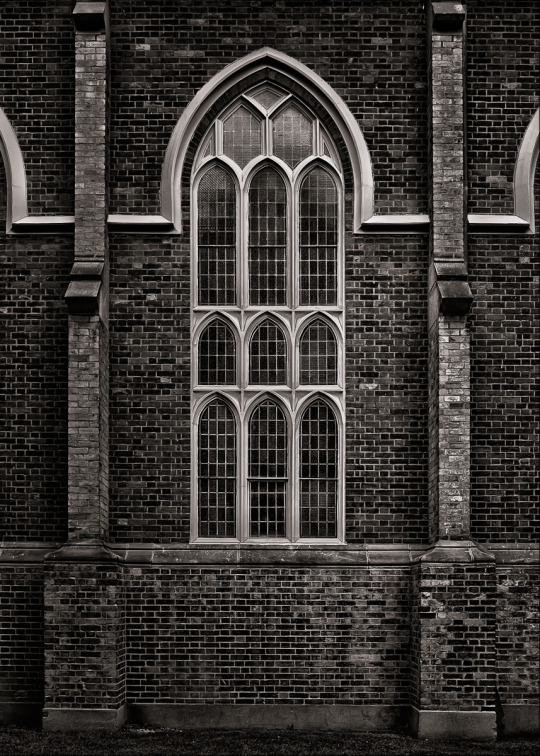
Little Trinity Anglican Church No 1.
Constructed in 1843 and rebuilt after a 1889 addition was almost completely destroyed by a fire in 1961, Little Trinity Anglican Church at No 425 King St E in the Corktown neighbourhood of Toronto Canada is the oldest surviving church in the city. The building was designated a Heritage Property by The City of Toronto in 2002.
Original photography from 2021 using a Canon EOS RP body with a Sigma 24-105mm F4 DG OS HSM Art lens. Reprocessed using Silver EFEX Pro as a Lightroom plugin for the Black and White conversion.
Brian Carson
The Learning Curve Photography @
linktr.ee/thelearningcurvephotography
#photography#original photography#toronto#black and white photography#architecture#photographers on tumblr#original photographers#black and white#bnw magazine#lensblr
77 notes
·
View notes